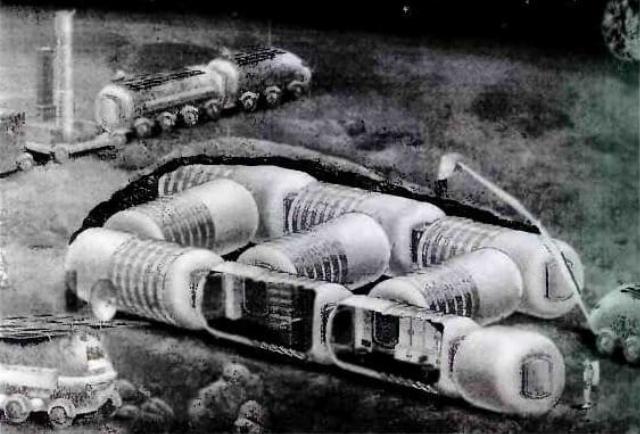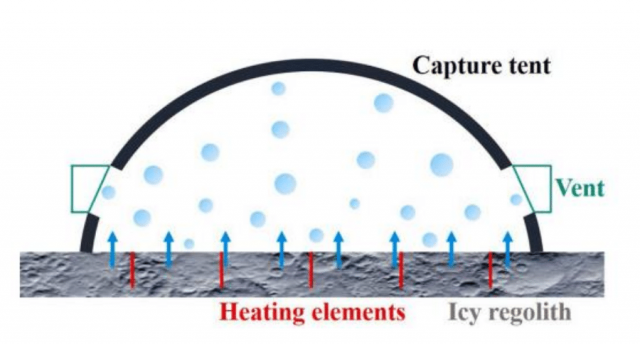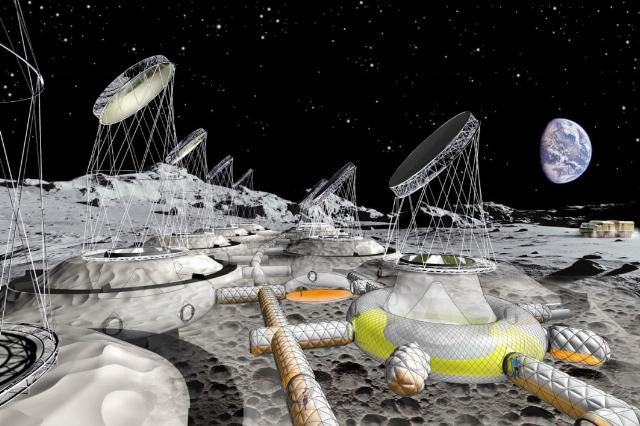Even without the reuse of water, humanity can deploy a fairly serious base at the south pole of the Moon, a new study has shown. However, this decision will have quite serious consequences. Moreover, the most likely path for the development of lunar bases does not necessarily require serious water consumption on a natural satellite of the Earth.
American researchers have calculated the water consumption for a large lunar base with an area of five hectares and a staff of 100 people. Moreover, contrary to the usual approach to such issues, they excluded the reuse of water and carried out calculations based on the assumption of a systematic release of waste water resources. The text of the work can be found on the Cornell University preprint server.
The projects of bases on the Moon were worked out back in the 1950s and 1960s, but they were normally very modest. For example, the Soviet project of the Zvezda lunar base from the 60s consisted of nine blocks of 73 cubic meters each (about 660 cubic meters in total) for 12 crew members. That is, in terms of volume, the base would be somewhat smaller than the modern ISS with a larger number of people. Of course, the project assumed the "ring" use of water: at that time it was believed that the Moon was practically waterless.

The concept of the Soviet lunar base of the 1960s, one of the variants of the "Star" / © Wikimedia Commons
In the 21st century, first a theory appeared suggesting the presence of large volumes of water in the form of ice on the Moon, and then specific observations (for example, radar) showing that the poles of the Earth's satellite have water ice. It became clear that there was no need to save water urgently. Moreover, with a large volume of water ice, it is possible to create significantly larger bases on Selenium than was thought possible half a century ago.
A new work by American researchers estimates the base's water supply to be 500 by 100 meters per 100 people. At the same time, the authors deliberately abandoned not only the mandatory reuse of water, but also its economy in general.: They calculate per capita consumption based on the earth's water consumption figures for the average American household (375 liters per person per day). According to calculations, the main part of the water will still fall not on people, but not on agricultural land (greenhouses with plants), which are inevitable for a self-sustaining colony.
According to new calculations, it is easiest to extract water from the lunar ice using automated "thermal drills" with a capacity of 10 kilowatts each. In total, about 6.5 thousand such drills will be needed.

The scheme of water extraction using a special awning. It is supposed to be deployed over the area of warming of the lunar regolith and the water ice under it / © Jeffrey S. Lee et al.
There is no atmosphere on the moon, so the ice under the regolith layer immediately turns into water vapor when heated. The researchers proposed to assemble it with a special awning stretched over the place of work of thermal drills warming the regolith. Then the water vapor is piped away from the awning into a tank, where the vapors condense to liquid water.
Then the scientists analyzed the water consumption of the base. It turns out that even if you get all the oxygen for breathing not from greenhouses, but due to the electrolysis of lunar water, this will take only 0.3% of the water needs of the entire base. A lot of water will have to be spent on greenhouses. The area needed to provide people there, the researchers determined at 370 square meters per person. These are very large indicators taken from the productivity of agricultural greenhouses on Earth. The calculations are seriously questionable: in the 1970s in the USSR, in the BIOS-3 experiment, it was established that less than 150 square meters were enough to provide one person with oxygen and food.
Scientists estimated the total water needs of the base at 105 thousand tons per year, which turned out to be quite lifting for extraction from lunar ice — in the presence of heat sources with 65 megawatts (thermal) capacity. This is not a very large amount: one Russian icebreaking reactor has several times the thermal power. At the same time, the work does not consider the source of such heat itself. Moreover, the researchers proceed from the option of supplying the base with energy due to solar radiation.
Therefore, they considered it reasonable to locate the base at the Shackleton de Gerlach ridge, located almost at the south pole. The top of the ridge is illuminated by sunlight almost always, and there are zones of eternal shade around, where the soil always has a temperature of about minus 250 degrees. Scientists believe it is reasonable to place solar panels on high ground, and to melt water ice in the lowlands.
The scientific work has a number of non-obvious places. For example, the total volume of the base (including the leaky one) is very large — up to 300 thousand cubic meters. Such a base is too big for 100 people.
Finally, the very idea of a lunar base on the surface raises questions. The fact is that today the moon landing is planned using only one landing system — Elon Musk's Starship. Its hermetic volume is about 900 cubic meters, more than that of the ISS or the Soviet lunar base of the Zvezda project. Each Starship can accommodate up to 40 people on a long-term flight. To accommodate 100 personnel, it is much more logical to land a certain number of such ships at the south pole of the Moon, since their serial cost is estimated at several hundred million dollars, which is not so much. And not to build a cyclopean base there with total dimensions exceeding 300 thousand cubic meters.
As noted above, according to the experience of the Soviet BIOS-3, 150 cubic meters of airtight space per person, including living and laboratory rooms, are enough to supply people with oxygen and food. Thus, even in the case of a permanent base for 100 people, it is easier to deliver 16 Starships to the Moon than to build structures the size of a rather large high-rise.
Nevertheless, the part of the work in which it is proposed to collect water under the awning with thermal drills looks quite interesting. Traditionally, water ice was supposed to be cut down from regolith, and then transported to melting points. This is how water is extracted in winter in some areas of Yakutia (due to permafrost in winter, other methods are difficult). However, the physical work of cutting water ice at minus 250 degrees will be quite difficult. Space automata without human guidance, as we have written more than once, cannot cope with complex work on the surface of other celestial bodies. And it will require a lot of time and effort from an astronaut. Melting the ice with heat looks like an easier option.

